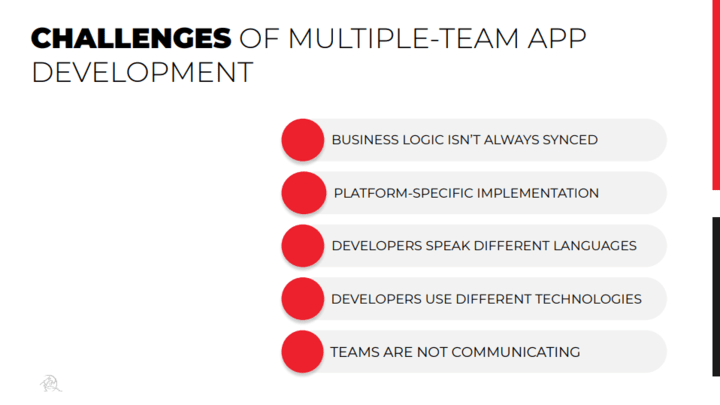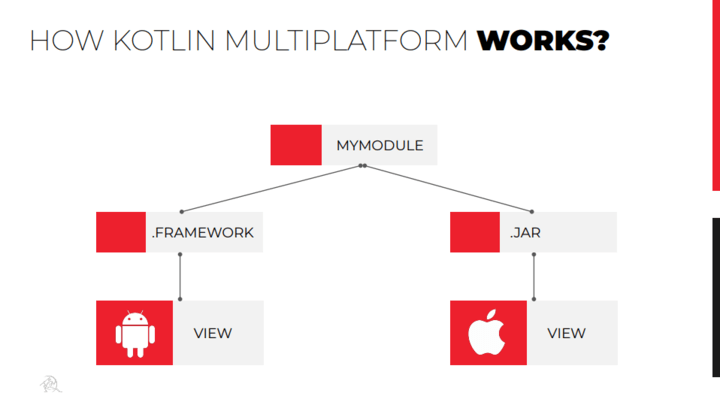How Kotlin Multiplatform Helps Reduce App Development Time
Applying the Kotlin Multiplatform can decrease the estimated time of development by up to 30 percent. Does this sound good? Let’s figure out exactly how you can implement this.
With 100 million startups launched annually, the time it takes tobring the product to market becomes even more critical consideration than even the money invested in the development. Users are becoming more and more demanding of the applications they want to use, so native solutions remain the best alternatives.
However, creating an application for Android, iOS and the web can mean triple the development cost. The only way to avoid this is to create a piece of universal code that works the same on all platforms. Let’s discuss how to achieve this.
CHALLENGES OF MULTIPLE-TEAM APP DEVELOPMENT
As a rule, when developing multiple native applications, different teams work independently during the process. It would be wrong to assume that development teams for different platforms should not interact in the process of creating the final product. Here are some potential challenges in multiple-team app development.
DIFFERENT APPROACHES TO PROBLEM-SOLVING
Two independent teams can come up with completely different approaches to solving a client’s problem. As a result, the final versions of the product for different operating systems will offer users different experiences, especially if the user has different gadgets to run the same application on like an iPhone, Android tablet, and Windows desktop.
COMMUNICATION ISSUES
Communication tests are used widely in remote and dedicated teams. This becomes an even bigger problem when two teams simultaneously create applications for different operating systems. For example, the customer can change the development course for one of the teams but leave everything as it was for the other. In the end, this produces two different results.
PLATFORM-SPECIFIC CHALLENGES
Each of the operating systems has specific requirements for the quality of the product, and especially for the user interface that must match the design of devices that use this OS. Programming for each platform involves the use of specialized languages, frameworks, and libraries. In this case, the task of the developers is to build the two applications as identical as possible based on the specifics of the UI.
TEAM INTERCHANGEABILITY
In an ideal world, the code created for each of the operating systems should be so clean that any programmer who knows a certain language can understand how it works. In reality, spaghetti code is more common. This complicates the option of substituting team members since a beginner spends too much time figuring out what code was written before they got involved.
CROSS-PLATFORM TECHNOLOGY: CAN IT SOLVE THE PROBLEM?
It may look like the only way to synchronize the development by teams is to use one of the cross-platform technologies. These are tools capable of storing the code written for different operating systems. However, cross-platform technologies are not as good as one would hope.
DISADVANTAGES OF CROSS-PLATFORM SOLUTIONS
- Hard access for low-level system API
- Late updates
- Not able to work with legacy code
- Most cross-platform software development kits (SDKs) are in beta or experimental stages
- The same app appearance is on all platforms which can spoil the user experience
KOTLIN MULTIPLATFORM FOR CROSS-PLATFORM APP DEVELOPMENT
These potential problems are not so bad though if you know what solutions to use to solve the issues of cross-platform development. Our team prefers to use Kotlin language to speed up development and improve the interaction between two or more separate teams.
What is Kotlin Multiplatform? It is an open-source programming language that allows you to create the cleanest code possible. With its help, there is no need to do the same work twice. For example, if we are creating an app for Android and iOS, we can share and use the same code for parts of the app.
HOW KOTLIN MULTIPLATFORM WORKS
Kotlin for Android, iOS, and other popular operating systems allows you to store the code pieces that are reusable for two or more versions of the app. We write all common code using Kotlin, and then the common code is transferred to native frameworks with a link into native Android and iOS projects.
It’s always possible to create some features in native environments if it is not practical to design them with Kotlin. That is why this approach is without risk when we need to come up with two or more solutions for different platforms. And this is not the only advantage.
ADVANTAGES OF KOTLIN MULTIPLATFORM
Here are the main ones:
- Significant savings. Using Kotlin for mobile and web development, it is possible to save 30-50% of development time. Kotlin can cut 40% of code lines, compared to Java. Kotlin saves you money since you don’t pay the developers for doing the same code two or more times.
- Fewer bugs. Kotlin allows developers to create the cleanest code. However, if some bugs have penetrated the code, it is possible to find and fix them before runtime, thereby saving you time and money in the testing and quality assurance (QA) processes. Here is a quick guide on how to estimate the cost and time needed for software testing.
- Team efficiency. Kotlin helps the teams interact and be more effective since they can focus on the next tasks. What is more, you can split tasks between developers. For example, the Android team may work on user signal inflow and the iOS team can work with the post-create flow. In the next sprint, the Android team can include code written by the iOS team and vice versa.
- An almost-native solution. Kotlin code is very similar to Swift and is 100% Java-interoperable.
DISADVANTAGES OF KOTLIN MULTIPLATFORM
Despite all the advantages, there are also some disadvantages to keep in mind before deciding on using Kotlin programming language.
THE TECHNOLOGY TAKES TIME TO LEARN
The developers who want to master this tool often ask something like how can I learn Kotlin for free or how long will it take to learn Kotlin? You can learn the basics for free, and you will need less time to learn how to use the technology if you already know Java. You shouldn’t expect your development team to switch to Kotlin in a few hours. This transition to Kotlin requires additional time and expense to train the team.
But is Kotlin better than Java? It may be better or worse depending on the goal you want to achieve.
MULTITHREADING CHALLENGE
There are some limitations to using this technology for source code. One of them is multithreading. Multithreading in Kotlin is based on Coroutines technology, which isn’t supported in Swift. But we do have some tools and workarounds to fix it.
NOT SO MANY KOTLIN EXPERTS IN THE MARKET
It is definitely much easier to find a Java developer or Swift programmer, but it will be much more difficult to find one who knows how to use Kotlin. You should hire the programmers who already have experience with Kotlin multiplatform development to be certain they will be able to complete the task at hand. Keep in mind that it will not be easy to replace them since the technology is not as widely used as native programming languages.
CONCLUSION
Fortunately, Cprime employs experts who consider Kotlin to be an effective solution since they are aware of how well it works. If you are thinking about creating a solution for two leading platforms plus a web version, hiring our Kotlin experts can be a win-win deal. Let’s get in touch and we will explain how the Kotlin multiplatform tool can benefit your specific project!
Contact our team at learn@cprime.com for more information.




